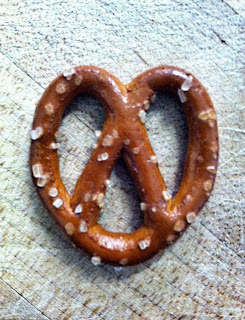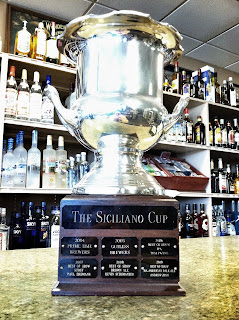 |
| Christina's Quinoa salad |
Former staffer Wes Eaton gives us the dirt on a month-long detox program he and wife recently completed. Wes includes a great-looking Quinoa recipe at the end of the essay. Note that Siciliano's now carries organic Quinoa in bulk ($3.99/lb) as well as the Agave nectar also called for in the recipe.
By Wes Eaton
I get a lot of strange looks from people when I tell them I’m on a “cleanse.” If they know me, they wonder how I can go day after day without a pint, a sip of wine, some local sourdough, an afternoon square of chocolate, a slice of pizza from Harmony, a morning cup of coffee. People of less acquaintance wonder if I have health problems, or if I feel the need to lose some weight, and fast. The idea of withholding the simple gratifications of good food and drink is somewhat mysterious and perplexing if you see no reason or hear no calling.
When I was younger, I remember my mother would wilt spinach and toss it with vinegar. She liked it because it tasted good, sure, but she also knew that it was good for her, and sometimes she just desired ‘healthier’ foods (why not fresh spinach in a simple salad, I’ll have to ask her). Mind you, she raised us on Butternut Bread, Margarine, and Kraft Mac & Cheese and I’ve had a sweet tooth ever since, one I now nurture with deep red wines, rich ales, and bourbon.
And here I must make a fine distinction as to my motivation to cleanse, as we certainly all must confront our drive to be successful on such a quest. After a hearty season of celebrating, with a follow-up go at moderation, I was still essentially on a trajectory of gourmand decadence. Not in pounds per say, but in my very joints and tissues I felt I was weighted down, a little stiff, and due for an oil change. My hero
Jim Harrison often writes about the morning bowl of oatmeal he takes as his penance for partaking too much the night/week before. On my new cleanse, however, not even simple oatmeal was permitted.
In some ways, a cleanse is like a fast. The way substances and toxins, products of immoderation and hedonistic cuisine, build up in one’s body over time, compounded with the unequal and unjust ratio of calories in versus calories expended, I felt I could go a few days without food and be none the worse. This was a romantic—as in fictional—understanding. One gets hungry if breakfast is missed, and by lunch, other options seem worth exploring. After all I did not have a religious calling to sacrifice eating, but rather a desire to freshen up and lose some clinging tension.
I believe in the importance of ignorance, and one of the many ways our Cartesian scientific roots has led us astray is with the false dichotomy between the mind and body, the intangible and the material. The important ignorance here is the conviction that our “self,” as in, how we go about choosing to “be” in this world, primarily comes about from conscious and mental decisions. On the contrary, I feel my whole body is very much part of my mind. And while a fast may lead to religious clarity, or supply the proper lucidity for a vision quest, I needed something more sustainable and doable in the sense of alignment with the other requirements of my life, which presently include reading, writing, and discussing—things that come as a challenge to me on an empty stomach.
The point of a cleanse, however, is not just to counteract individual, personal decisions about what to eat. As any literature on cleansing will remind you countless times, we live in a toxic world. Much of this toxicity can be traced to under adjudicated (as in less than democratic) forms of technologically aided industrial production. Rachel Carson first raised our awareness of the links between environmental degradation and health risks in 1962 with the publication of her book Silent Spring. So a cleanse aims to rinse our bodies of the toxins that come through our skin, or enter with our breath, as well as those we knowingly, or unknowingly, ingest. By cleansing, we heal ourselves of the malicious and creeping side effects that toxins foment.
So unlike a fast, we do eat on a cleanse. But what? There are many cleanse variations. The Master Cleanse, a liquid detox program, prescribes water with lemon, maple syrup, and cayenne pepper for as many days as you can take. Other variations include juice fasting, or blended fasting. Raw Food diets have been associated with countless miracles, and Ayurvedic diets are also associated with detoxification, albeit at a slower pace.
The cleanse I am on, however, is called “Clean” (with a book of the same title). The aim here is to eliminate foods that are difficult to digest or that cause allergic reactions (many of which we are so accustomed to we fail to make the connection between a range of discomforts and our foods). There are two parts to this. First, agitating and loosening toxins from our body. Some of the above practices can do this. But the second part, flushing those toxins by linking them with certain foods is the particular advantage of the “Clean.” This means removing dairy, sugar, most meats, stimulants (caffeine, alcohol), and gluten.
At first glance this seemed daunting. Not only would I be hungry, but I would quickly need to learn to cook new dishes, and drop the habit of eating out. Instead of BLT’s, egg sandwiches or sandwiches of any kind, spaghetti, risotto, roasts, steaks, burgers, chips and salsa, not to mention IPAs, I would need to get by only on brown rice, raw veggies and fruits, a little fish and lamb, and nuts. While I’ve no room to spell specifics, essentially, going on “the Clean” means fruit smoothie for breakfast (fruit with almond or coconut milk, hemp protein, and cinnamon, for instance), a balanced lunch, such as salad, beans, Dal, veggies, fruit, Quinoa, and another smoothie or bowl of soup for dinner, drinking lots of water, and ensuring twelve hours between “dinner” and “breakfast.”
As I close out the last week of the four week program, I’d like to present some things I felt were key to my success (yes, I made it). The first, and most important, was doing the clean with a partner: my wife Christina. Cooking for one is very challenging, especially when you’re cooking new dishes and can’t fall back on your intuitive stock of kitchen knowledge. Christina studied the Clean book while I simply studied. She selected recipes, made countless lists, trips to Horrocks, winter farm markets, tried new creations, and, most importantly, meal-planned and cooked.
In short, we were thoroughly prepared, which is the second key. The third key was chicken stock, homemade. I often roast birds from the Rakowski’s (regional farmers) and make stock from the carcasses, we used our freezer full for brown rice, soups, and bean dishes, adding savory flavor. The final key was finding dishes that we liked, that were satisfying. For my sweet tooth, mangoes and fresh pineapples have been monumental. For drink, fresh fruit juices and sparkling water. For substance, the indispensable Quinoa. To close, I want to elaborate by sharing a recipe worthy of anyone’s plate. Inspired by a recipe in
Clean, Christina made some changes and adapted what’s now one of my favorite lunches.
Christina’s Quinoa Salad
(Inspired by Alejandro Junger)
- 3 cups cooked Quinoa (start with one cup dry, try white or red)
- 1 tablespoon chopper parsley
- 1 cup currants
- 1/3 cup chopped raw almonds
- 1/2 cup diced carrots
- 1/2 cup mint
- 1/3 cup chopped scallions
- 1/2 cup (or more) fresh lime juice
- 1 1/2 tsp agave nectar
- 1 tsp ground cumin
- 1 1/2 tsp sea salt
- 1/3 cup olive oil
- Directions: simply mix together and enjoy.



.JPG)












